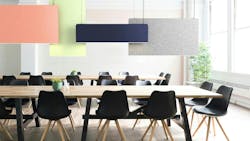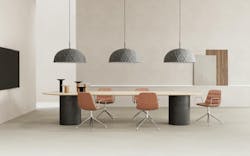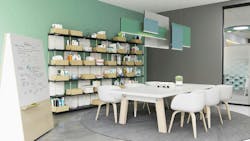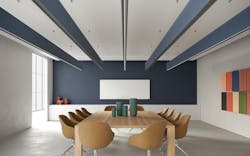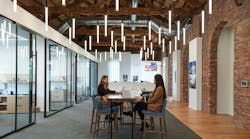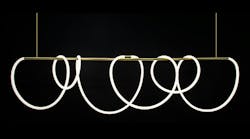Given challenges such as the shift towards hybrid learning and the growing preference for wellness-focused, community-oriented amenities, colleges and universities are actively pursuing strategies to revitalize their existing infrastructure and create spaces that appeal to the post-pandemic generation of students. Acoustic lighting fixtures offer an opportunity to meet the evolving needs of modern learning environments, providing a multipurpose solution that incorporates sound management, energy-efficient LED lighting, aesthetic appeal and adaptability.
Managing acoustics
In educational settings, excess noise levels pose a significant challenge, impacting the well-being, concentration and overall learning experience of students and educators alike. Designers must delicately balance the need to reduce background noise while creating spaces that encourage collaboration and discussion.
Acoustic lighting offers a versatile, environmentally friendly solution, reducing ambient noise by as much as 40% in controlled test conditions. Conversational speech is typically generated at head level and reverberates from the ceiling. Occupying the often-overlooked real estate between desks and ceilings, acoustic lighting fixtures help absorb the emitted sound waves directly above the source before they reverberate against the ceiling and walls and carry the noise across the room.
Acoustic light fixtures perform better than ceiling- or wall-mounted treatments of similar size and material because the lampshade’s interior and the exterior are exposed, doubling the functional surface area for sound absorption. They also are positioned closer to the sound source and therefore effective at impeding sound waves near their point of origin and in their primary path of travel. While valuable on their own, acoustic lighting fixtures also can enhance the effectiveness of other noise-damping materials such as soft furnishings or carpets.
Integrating acoustic lighting fixtures into classrooms, collaborative workspaces and larger areas like dining halls and libraries not only improves communication between educators and students but also helps students focus and engage without the added stress of noise pollution.
Optimizing light
In addition to acoustic performance, proper lighting is pivotal in creating an optimal learning environment because it directly influences health and productivity. Four main components contribute to well-lit educational spaces: light layers, color temperature, glare reduction and control.
Light Layers. A successful learning environment should incorporate three layers of light: general lighting, task lighting and daylighting. Lighting fixtures can be strategically located and hung at different heights to achieve these layers, enhancing the overall illumination of the space.
Color Temperature. The ideal color temperature for a learning space falls within the 3000K to 3500K range. This range isn’t too cool to give the impression of a sterile environment, but it is not too warm to create a cozy environment where students might want to nap.
Glare Reduction. Glare can cause discomfort, leading to squinting, eye strain and headaches. Acoustic lighting fixtures help minimize glare, creating a comfortable and productive environment for students and educators.
Control. The ability to control lighting conditions throughout the day is crucial. High quality acoustic lighting solutions provide flexibility, allowing educators to adjust light levels for different activities and times of the day.
Aesthetic appeal
Employing acoustic lighting doesn’t mean you need to sacrifice beauty in the interest of practicality. Available fixtures are styled to fit within many color schemes and design trends with unique shapes, colors and sizes. Whether it is elongated, linear lamps spanning across an expansive room, large sweeping pendants delineating collaboration zones, or smaller pendants artfully grouped at varying heights for a captivating visual display, there's ample opportunity for creativity and style.
Beyond their visual appeal, high quality acoustic lighting fixtures offers durability and longevity, requiring minimal maintenance. Often, the acoustic panels are manufactured from dense polyester fiber material that includes 65% post-consumer recycled content and is 100% recyclable. These fixtures have flat, smooth surfaces that deter dust and debris accumulation, making them suitable for educational settings with rigorous hygiene standards.
Adaptability
As construction and operating costs continue to climb, many higher-ed institutions are opting for adaptive reuse, renovating and repurposing existing buildings. For example, converting an old dormitory into a library or amenities space presents an opportunity to enhance the environment without the need for extensive modifications to ceilings or floors. In such scenarios, acoustic lighting can be seamlessly integrated to create an optimal study environment.
With a straightforward installation process, acoustic lighting fixtures can be implemented quickly with minimal labor required. When the purpose of the space changes, the lighting pendants can be moved and reused. And because they hang from the ceiling, square footage is freed up in the floorplan for additional furnishings and decorations.
